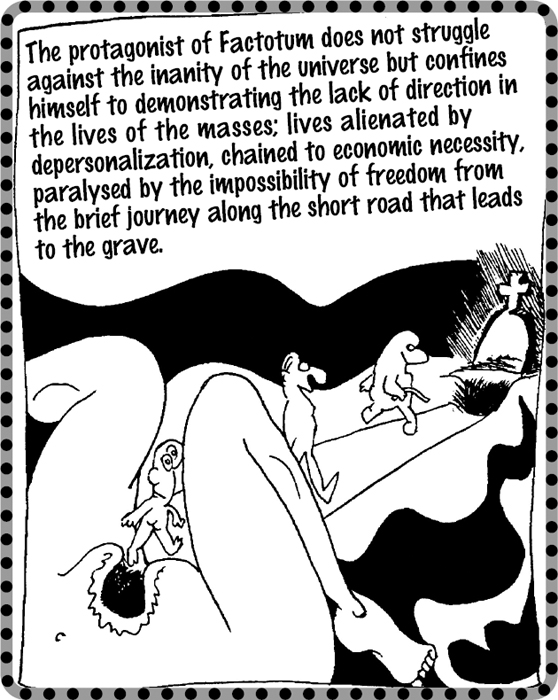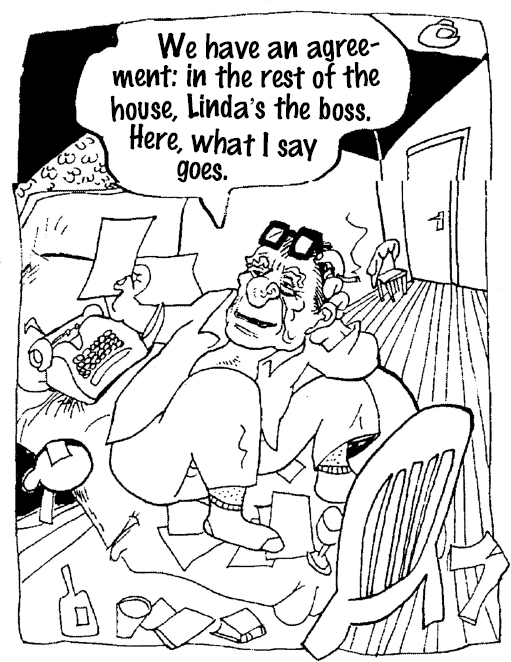
The title of his next book heightened his risqué image. It was a book of short stories called Erections, Ejaculations and General Tales of Ordinary Madness (1972). Hank saw this book as fodder for the monster book trade, giving him time to write his second novel Factotum. Before that came out, he published another book of short stories, South of No North (1973), which must have given the impression that, far from being a conventional writer, Bukowski was an assembly line. Most readers were unaware that his productivity stemmed from the autobiographical nature of his work and that this kind of writing was a form of therapy.
His method was simple: he got over his past by making it public. And he got paid for it! In the seventies he published ten books, one a year on average.

In ‘Guts’, one of the best stories in South of No North, Hank described himself:
Like anybody can tell you, I am not a very nice man. I don't know the word. I have always admired the villain, the outlaw, the son of a bitch. I don't like the clean-shaven boy with the necktie and the good job. I like desperate men, men with broken teeth and broken minds and broken ways...I'm more interested in perverts than saints. I can relax with bums because I am a bum. I don't like laws, morals, religions, rules. I don't like to be shaped by society.
This is how he describes the moment when he was first confronted with an unfamiliar world which needed to be conquered:
Frankly I was horrified by life, at what a man had to do simply in order to eat, sleep, and keep himself clothed. So I stayed in bed and drank. When you drank the world was still out there, but for the moment it didn't have you by the throat.

In 1982, Fernanda Pivano, a literary critic, published a book that included a transcript of a three-hour interview with Bukowski. What I Like Best Is Scratching My Pits marked Factotum as the beginning of Bukowski's maturity: according to Pivano, it gave a better account of the author's development than his previous stories had done, and it abandoned the ingenuousness of his early works.

Inspired by his relationship with Linda, Hank finished his third novel, Women, in October 1978. It is his longest book — 433 pages divided into 99 chapters. Women was partly inspired by Boccaccio's Decameron, a book in praise of eroticism.
In it, he focuses on his first years of fame. One critic complained that, as a novel, Women lacked structure. Hank agreed.

Women is not about love but about sex. It deals with his relationships with twenty or so women of all kinds. Those encounters occurred after a four-year period of celibacy resulting from the alcoholism that nearly killed him. The book could be seen as a farewell to those crazy years, since he had found the woman of his dreams and his wayward past needed to be buried. In fact, this third volume of his lengthy review of the past begins to dispel the grief that shrouds Post Office and Factotum. From it emerges a kind of joyousness, though it is sprinkled with irony.
The book begins with a typical complaint:

And it ends with his meeting an old cat on his doorstep. The meaning is clear: women may stream through a man's life but in the end he is alone, and must prepare himself for being alone. In one passage, he writes:

Fernanda Pivano concludes: ‘Now Bukowski is writing without insecurity. He writes with unquestionable facility and agility. Clearly that derives from years of experience. He is aware of his place among other important writers, but he continues to display his disapproval of official culture’.

In love with Linda, with whom he frequently went to the races, and maintaining a simple, low-profile lifestyle, he published more than ever before.

His publishers pointed out that it was not a good idea to saturate the market but that did not matter to him. In the middle of 1977 he was producing, on average, twenty poems a week, along with prose narratives.
His book of poems, Love is a Dog from Hell (1977), contained much of the groundwork for his fourth novel (Ham on Rye); it reviews the extraordinary series of relationships he had had with women of all classes and backgrounds. Bukowski was bidding a public farewell to the dissolute life. Sentimental anarchy was almost at an end. And he was no longer alone, nor would he ever be again.

In 1988 Linda and Hank bought a house at San Pedro, in the north of Los Angeles, close to the sea and to the highways that would take Hank to the racetracks at Santa Anita and Hollywood Park. He was earning so much in royalties that, on the advice of his accountant, he converted that capital into real estate in order to pay less tax. In his fifth novel, Hollywood, he recorded that...

This period gave rise to the image of Hank as a hard-hearted, macho man and as a loath some misogynist. Many readers who were not au fait with his life history took the descriptions in Women as an indication of his true personality. When the critics took him seriously, he responded in an interview:

Soon after, there was a militant feminist demonstration against him. Hank was annoyed at first but then responded with humour.

It is ironic that those critics attacked him at the very time when he had at last found—as he had prayed for, years before, in a poem—‘a decent woman’ to whom he could, without embarrassment, say the words ‘for always’.

Hank would live in the San Pedro house until his death. There he had the privacy he needed and a peace without precedent. He extended his study by putting in a kind of alcove with a skylight, where he wrote at night, while Linda was sleeping.

‘There is only one place to write and that is alone at a typewriter. The writer who has to go into the streets is a writer who does not know the streets ... when you leave your typewriter you leave your machine gun and the rats come pouring through.’
Hank's old friends were amazed to see him adapting to a clean, ordered house, with all the trappings of the wealthy Los Angeles middle classes. But most of all, their eyes were drawn to the picture of the guru above the door. Had Hank been converted as well?
